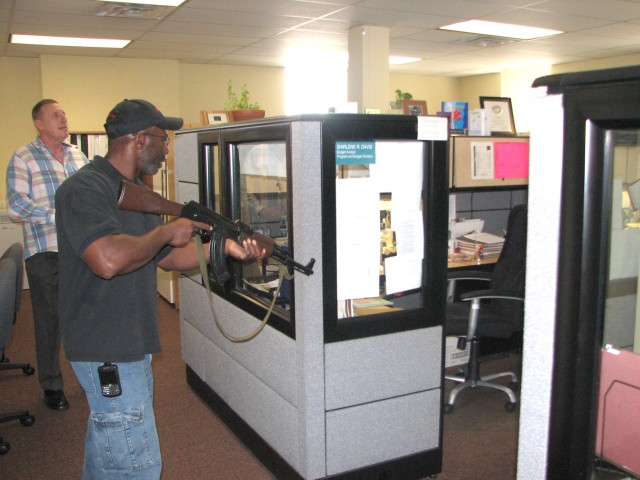
FORT MCPHERSON, Ga. -- We've all heard the term "Be Aware of Your Surroundings," however, we don't really give it too much thought when we are working at our desk or office during a normal day.
While this term is something everyone should follow, will it help identify an active shooter before he or she strikes' Fort McPherson and Fort Gillem have incorporated active shooter training into its antiterrorism awareness campaign, using the installations' philosophies of "train as reality" and "knowledge is power."
When training is conducted, we try to make it as real as possible and instill the knowledge of the immediate actions to take in an active shooter situation.
This is accomplished by using training weapons that may appear real and using sound effects and role players as active shooters to provide the "real-life" effect.
Additionally, Civilian employees, Soldiers and Family members are put in active shooter training scenarios and must take immediate actions to react.
Active shooter training is being conducted in three phases using both the individual and collective training concept.
The first phase is classroom training for supervisors and building managers; they in turn use the knowledge gained to train their staff and building occupants.
The second phase is a hands-on training that has individuals actually respond to an active shooter situation in a building or facility.
The third phase is a collective training scenario as part of an anti-terrorism exercise. Training for an actual active shooter situation is extremely difficult for anyone in any environment.
The potential instability of any active shooter, along with his or her motives and mindset, are almost impossible to prepare for.
Situations are very unpredictable and most come with no or very limited warning time. There may be almost no reaction time, therefore you have to protect yourself any way you can.
The first and most important action to take is to attempt to escape the scene or building in the fastest way possible.
This can be difficult to accomplish without putting yourself in the line of fire of the shooter; however, the idea in an active shooter situation is to get out in the quickest and safest way possible.
Don't stop to pick up personal belongings, lock doors or treat the wounded. Get to safety as quickly as possible.
The wounded will be treated by professionals when it is safe.
When escape is not possible, the second action to take is to hide.
Hide in any way and anywhere possible, and take the best cover and concealment that you can. Lock yourself in offices and hide under a desk or behind filing cabinets.
In many cases, active shooters will shoot through doors and walls, especially if they are looking for a specific target.
Therefore, don't stand against doors or walls if you are locked or barricaded in an office. Hide behind additional cover and stay low to the ground.
The third and least recommended action is to attack.
Attacking an active shooter is extremely dangerous and should only be attempted as a last resort. If you feel you have no chance to escape or hide, attacking may be your only option.
When individuals come to the point of being an active shooter, in most cases they are not afraid of death and may have no feelings for the people they may be shooting.
They are normally motivated by anger, being an outcast or seeking revenge. In some cases, they are motivated and are supported by terrorists or extremist views, but in almost all cases they cannot be stopped unless they are stopped by law enforcement or suicide.
Fort McPherson and Fort Gillem law enforcement and security professionals do their best to keep us safe and protected on a daily basis; however, it is unwise to get a false sense of security by thinking we are safe from a major criminal or terrorist act because we are on a military base. Everyone must know the immediate actions to take in an active shooter situation and should train and practice so they are instilled behaviors.

Social Sharing